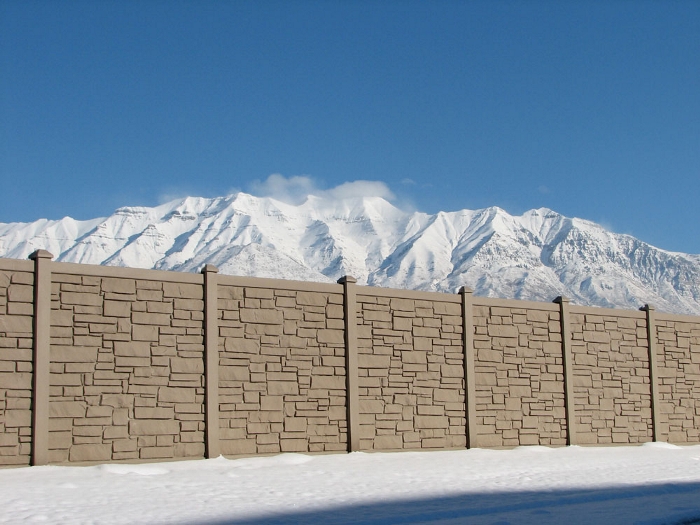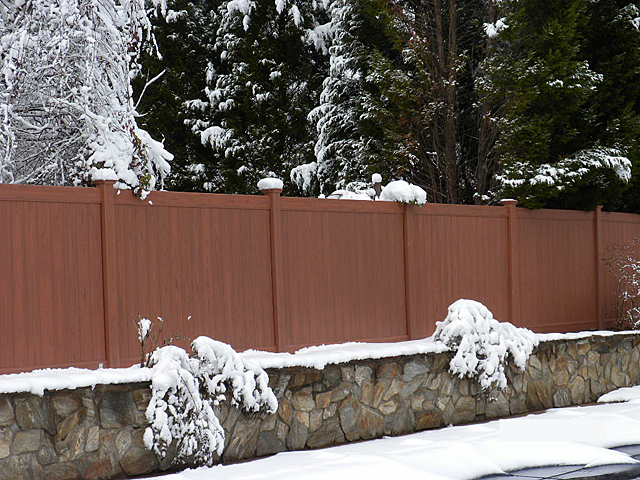5 Environmental Factors That Prove Vinyl Is the Best Weatherproof Fence

A fence is a perfect addition to any yard. Weeks of planning goes into installing it around your yard and the last thing you want is for it to come down.
Unfortunately, there’s only so much we can do as fence owners to protect it from the elements. Rain is going to fall and the sun is going to shine. The best option is to fight back with a maintenance-free vinyl fence.
Here are the five most prominent environmental dangers that vinyl fencing can deflect, making it the best option for a weatherproof fence around your back yard.
1. Corrosion
Corrosion caused by rain is one of the most common dangers to any fence. Metal fences have a hard time keeping their shine throughout the years when rain is a factor in your climate.
Moisture is equally detrimental to wood. After time, it wears away wood fibers in a process called delignification which weakens wood fences.
There are strategies used to combat corrosion from having an effect on your fence. Expensive stains can be purchased and applied to your fence every year to help protect the wood. This won’t prevent your wood from developing moisture damage, but it can help to slow the process down.
Vinyl Makes for a Waterproof Fence
Vinyl material gives you a naturally waterproof fence. There’s no need to spend money on costly stains and paint that you have to apply to a wood fence every spring.
2. Extreme Wind
Natural disasters such as hurricanes and tornadoes are unavoidable if you live in some parts of America. But the one weather pattern that is consistent across the country is wind.
If your property sits on higher ground or in a valley, strong wind gusts are a part of life. You may be accustomed to the wind whipping around but your fence will take some damage.
If your fence posts aren’t installed properly, they will be vulnerable when the wind begins to swirl. In addition, if your posts aren’t deep enough in the ground, they can slowly shift and cause the rest of the fence to lean.
Vinyl Fences Can Withstand up to 130 MPH Winds
Vinyl Fence Wholesaler fences are certified to withstand gusts of up to 130 mph. The flexibility of the panels also allows the vinyl to reset after heavy winds.
You can also ground vinyl fence posts with another material. A fence with concrete footing is more stable in the ground, making shifting nearly impossible.
Our vinyl fences can withstand wind gusts of up to 130mph! Watch our video to see how our fences are ready for the toughest environments.
3. Insect Infestation
Wood fences in warmer climates are a big target for insect infestations. Here are some of the most common insects that can damage your fence.
- Termites
- Wood-boring beetles
- Carpenter ants
Termites love eating any type of wood. They either nest in the wood or underground, and are capable of spreading their colonies quickly.
Wood-boring beetles are similar in that they love feasting on wood. They make their holes inside your fence and lay their eggs. Once they hatch, the larvae remain in the wood for months, eating away at the wood until they grow wings and find more wood elsewhere.
If you live in a notoriously humid climate, you should keep an eye on your fence for these wood-boring insects. Here are three signs your fence could be infested.
- Insects flying around your fence.
- Random holes found in fence posts.
- Mounds of dirt at the base of your fence.
Carpenter ants are another danger to your fence. They differ from regular ants because of their size and rounded thorax. Unlike termites and wood-boring beetles, carpenter ants gain no nutritional value from wood. They simply burrow into moist wood to nest, making your wood weaker.
Vinyl Doesn’t Attract Bugs
Vinyl is a plastic material that doesn’t attract bugs. Humid conditions don’t soften vinyl like it does wood, making it weaker and easier for bugs to infiltrate.
If the aesthetic of a wood fence is what you’re searching for, try a simulated wood fence. These vinyl fences don’t attract bugs, are easier to install and last longer than real wood.
4. Sun Exposure
Prolonged sun exposure to your fence can do one of these two things to your fence depending on the climate you live in.
If you live in a dry, desert-like region, constant sunlight will make the color of your wooden fence fade over time.
If you live in a humid climate where both rain and intense sunlight are common, heat from the sun can dry moist wood and pull apart the wood fibers. This can cause the wood to splinter and warp.
Vinyl Lasts Several Decades
Vinyl fences will thrive in temperatures as low as -40ºF and as high as 140ºF without losing shape or color. You can also leave the expensive finishes in the garage because of the strength of these maintenance-free vinyl fences.
What makes vinyl stronger and more adaptable to sunlight — or lack thereof — is that it’s not porous. Wood is made up of fibers that change shape and expand when moist and then retract into their original shape when dry. This cycle ultimately leaves wood fences brittle and weak.

5. Frost Heaves
When the ground freezes in colder climates, anything buried in the soil is susceptible to frost heaves. This happens when the temperature is so cold, the moisture in the soil freezes. Because the soil is frozen, it expands and takes up more volume underground.
Frost heaves are accelerated when the underground frost line moves. When the temperature rises, the frost line becomes more shallow, leaving behind ice lenses. The ice lenses attach themselves to surfaces below the ground. These surfaces are pushed upward as the underground frost line shrinks, shifting the soil up toward the surface.
When the soil moves upward underneath a fence post, it pushes the post up. A fence post that is slowly unearthed is less stable than when you originally put it in the ground.
Vinyl Fence Posts Are Safe in Concrete
The best way to counteract frost heaving is to secure your fence with concrete footing. Concrete is safe to use on vinyl and is especially useful when setting posts underground.
The depth of your hole depends on how high your fence is, but a good rule of thumb is to bury your post a third of the way in the ground. Your hole needs to be just as wide on the surface as it is in the ground. Fill the bottom of the hole with pea gravel and pour cement on top and along the sides of the fence post.
At the end of the day, the best way to prevent nature from harming your fence is to use the most durable material. Vinyl fencing is manufactured to outlast wood and metal. Vinyl Fence Wholesalers offers a variety of vinyl fences that won’t decay over years of exposure to rain, frost and intense sun.
Vinyl Fence Wholesaler also offers 24/7 support if you’re installing a fence. You can contact us any time to get support when it comes time to build your fence.


